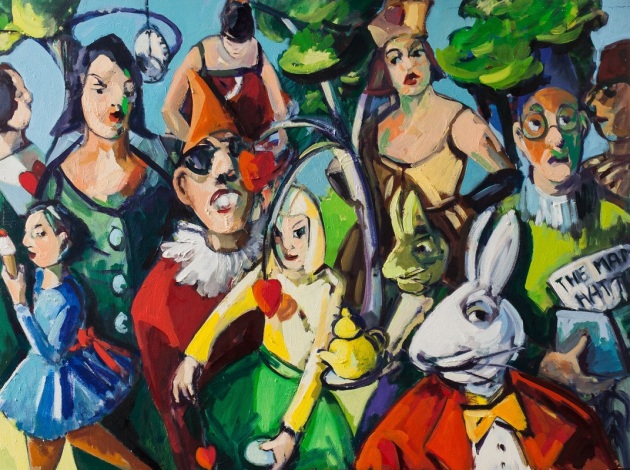Next year marks the 150th anniversary of the story of a little girl, wide-smiling cats, tea parties and a manic queen — otherwise known as “Alice’s Adventures in Wonderland.”
Not only is it the perfect time to dig up your copy of the book, or watch one of the movie adaptations, but you can also immerse yourself in Wonderland by visiting Pensacola Museum of Art and checking out “The Alice in Wonderland Series.”
British figurative painter and professor at Savannah College of Art & Design, Stefani Joseph, has brought the Lewis Carroll tale to life in her new exhibit.
Joseph began the Alice paintings after 16 years of working on a series that referenced deception, mystery and ambiguity.
“After these series, I wanted a change, a slightly new direction and suddenly I just thought of ‘Alice in Wonderland,’” she said.
A passage from the book inspired Joseph so much she put it in her artist statement:
“But when the Rabbit actually took a watch out of its waist-coat pocket and looked at it and then hurried on, Alice started to her feet, for it flashed across her mind that she had never before seen a rabbit with either a waistcoat pocket or take a watch out of it.”
The quote brought out a playfulness in the artist, which she incorporated into the paintings.
“I could continue the themes explored in my earlier works which relied on a more traditional and realistic approach, but now I could let my imagination have full reign,” she said. “I was no longer bound with perspective, proportion etc. Imagination, color and the pure joy of painting could come to the fore.”
No matter where it stems from, imagination is the ultimate key to any painting, Joseph said.
“For if there is no imagination, what can a painting be about? An imitation of what the eye can see, or a visual world of memory, of childhood and of characters that are so visually exciting they stay in our memory for many years to come.”
At PMA, that playfulness slips into the exhibit with a Wonderland-themed photo booth and a selection of vintage videos that will be playing in the children’s area to enhance the experience. This kind of interaction may help broaden the gap between regular museum visitors and newbies, said Alexis Leader, curator at PMA.
“Familiar subject matter, such as a timeless children’s story or identifiable imagery can ease this transition and introduce them to the arts in a creative space unburdened with a sea of terminology or artistic style references necessary to appreciate the work,” she said. “Joseph’s series is delight for visitors of all ages and its nonsensical fall through the rabbit hole as you walk from gallery to gallery leads through nearly 30 vibrant canvases of characters you know and ones you have yet to discover.”
Joseph admits she wasn’t always inspired by Alice or Wonderland, but had always been fond of the White Rabbit, who appears in one of her favorite pieces in the exhibit. When she first began painting 30 years ago Joseph was initially drawn to figurative tradition.
“I was born and lived in Europe for much of my life,” she explained. “I studied in the figurative tradition and never felt the need or desire to work in anything else.”
It’s quite a shift from representational art to paintings inspired by what is categorized as “literary nonsense.” Instead of painting from real objects, Joseph created the colorful scenes based on her creativity.
“I knew about the tea party, the Cheshire cat, the Garden of the Red Queen — and her conspiratorial character — and I then made my own scenes from imagination,” Joseph said. “Though, of course, subconsciously you never know what remembered images of the past filter through.”
From the original drawings inside the first edition in 1865, to the comic books and then, Disney movies, it’s hard for artists not to be inspired by the children’s classic.
“Carroll’s story of Alice has been adapted by artists for generations, from surrealists such as Max Ernst and Salvador Dali through pop and conceptual artists of the 1960s and 70s to contemporary artists, such as Joseph today,” Leader said.
There isn’t a huge takeaway message from Joseph’s “Alice in Wonderland Series” — there’s already a book for that. What the artist appreciates most is for people to enjoy themselves, which makes the exhibit a great choice to take restless holiday visitors.
“What I want people to take away from the exhibit is to enjoy the color, vitality and originality of the work,” she said. “With the holiday season, is this so wrong?”
As seen in Independent News
